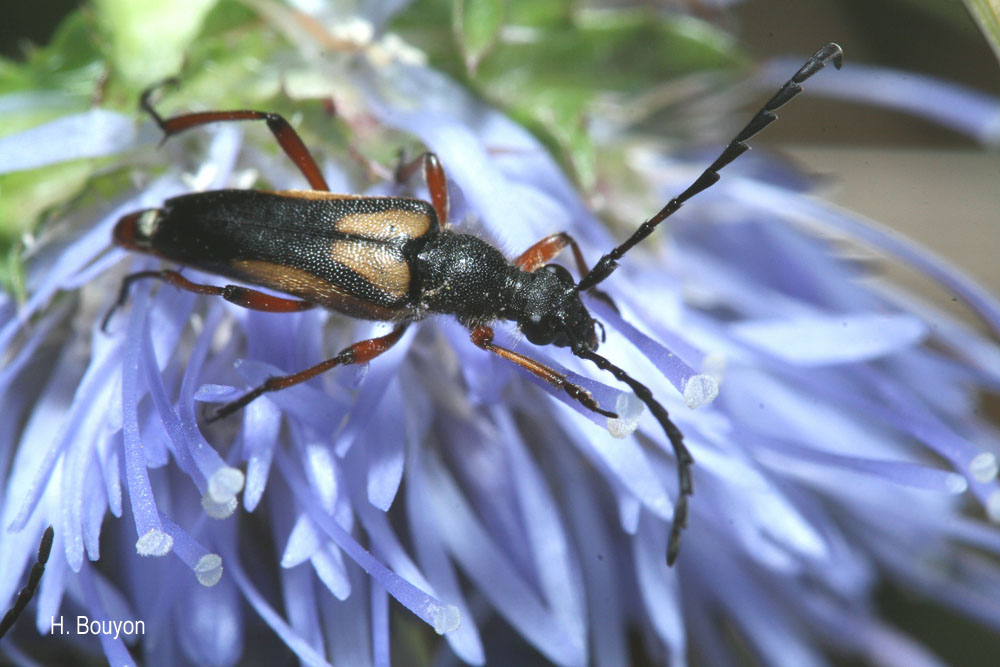
cd_nom

| Author : H.Bouyon |
 |
To get the picture, please visit:
Bouyon Hervé
herve.bouyon@wanadoo.fr
Any reuse of one or more photographs on this site is subject to an authorization request from the author.
Link to the Code of Intellectual Property (Legifrance)

| Author : J. Touroult |
 |
To get the picture, please visit:
Despite the Creative Commons license, please inform the author of the use which will be made of his photo

| Author : J. Touroult |
 |
To get the picture, please visit:
Julien Touroult
Muséum national d'Histoire naturelle
Service du Patrimoine Naturel
touroult@mnhn.fr
Despite the Creative Commons license, please inform the author of the use which will be made of his photo

| Author : H.Bouyon |
 |
To get the picture, please visit:
Bouyon Hervé
herve.bouyon@wanadoo.fr
Any reuse of one or more photographs on this site is subject to an authorization request from the author.
Link to the Code of Intellectual Property (Legifrance)
Taille (imago) : 7 - 15 mm
Diagnose : Lepture de taille moyenne, assez large, de couleur jaune et noire. Antennes plus courtes que le corps, nettement dentées (mâle). Thorax arrondi.Coloration très variable, jaune et noire au niveau des élytres; rougeâtre et/ou noire au niveau des pattes; noire ou annelée de jaune/rougeâtre au niveau des antennes.
Détermination : moyennement difficile; possible sur photo.
Espèces proches : La forme de coloration typique (antennes annelées, élytres noirs avec des taches jaunes vers la base et sur les côtés) est inconfondable. Les formes à élytres noirs peuvent être confondues avec d'autres leptures noirs mais s'en distingue notamment par la stature.
Période d'observation : Adultes observés de mai à août, avec un net pic en fin juin et juillet
Biologie-éthologie : Adulte héliophile et floricole. Larve dans les troncs et souches de résineux (pins, sapins). Cycle de deux ans.
Biogéographie et écologie : Espèce endémique du Sud-Ouest de l'Europe, répandue au Portugal et en Espagne; la France constituant sa limite nord de répartition. Assez fréquente dans les forêts de résineux, en moyenne montagne.
J. Touroult(UMS PatriNat (AFB - CNRS - MNHN)),2019
Continental
Metropolitan France
Overseas
Marine
Metropolitan France
Overseas
The map presents a summary at the 10 x 10 km grid of the observation data for the species transmitted to the SINP. These data have been subjected to validation filters.
The map presents a reference distribution layer of the species at the scale of departments and marine sectors. The presence and absence data were established by expertise within a network of partners. This reference distribution is used in the validation process of the SINP data at the INPN level.
Corresponds to a report on the basis of at least one observation proved within a period of 10 years (20 years for little-known invertebrates) preceding the year and no presumption of extinction since obtaining the last data nor doubt on reproductive and implemented nature of this population. For migratory species, the presence indicated concerns areas of reproduction.
This status is based on one or more of the following criteria:
This point covers the absence, more difficult by nature to demonstrate than presence. This status is based on one or more of the following criteria:
This status must be assigned to a department in which the presence of the species is casual.
Particular case of absence due to a proven extinction less than a half century ago (older disappearances are treated as "no probable or definite").
In the state of knowledge, we can not comment on the presence or absence in the current department. This is the default status when not comprised in one of the previous categories or whenever there is doubt.
The map shows the global distribution of the species based on GBIF data (Global Biodiversity Information Facility).
